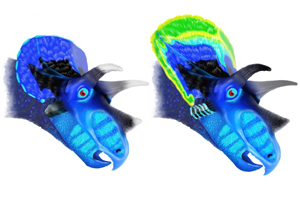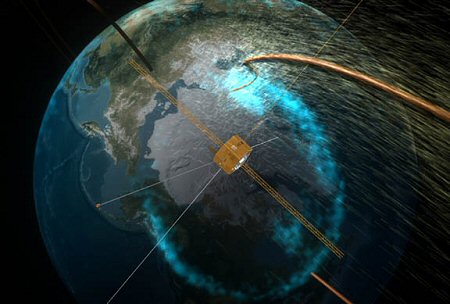
© Artwork by Holly Woodward, MSU graduate student.The classic image of a Triceratops is on the left. On the right is the new face of Triceratops, previously called Torosaurus.
Bozeman -- Research by a Montana State University doctoral student and one of the nation's top paleontologists is upending more than 100 years of thought regarding the dinosaurs known as
Triceratops and
Torosaurus.
Since the late 1800s, scientists have believed that
Triceratops and
Torosaurus were two different types of dinosaurs.
Triceratops had a three-horned skull with a rather short frill, whereas
Torosaurus had a much bigger frill with two large holes through it.
MSU paleontologists John Scannella and Jack Horner said in the July 14 issue of the
Journal of Vertebrate Paleontology, however, that
Triceratops and
Torosaurus are actually the same dinosaur at different stages of growth. They added that the discovery contributes to an unfolding theory that dinosaur diversity was extremely depleted at the end of the dinosaur age.
The
Journal of Vertebrate Paleontology is the official journal of the Society of Vertebrate Paleontology. Scannella is a doctoral student in earth sciences, and Horner is Regents Professor of Paleontology at MSU's Museum of the Rockies.
The confusion over
Triceratops and
Torosaurus was easy to understand, Scannella said, because juvenile dinosaurs weren't just miniature versions of adults. They looked very different, and their skulls changed radically as they matured. Recent studies have revealed extreme changes in the skulls of
pachycephalosaurs,
tyrannosaurs and other dinosaurs that died out about 65 million years ago in North America.
"Paleontologists are at a disadvantage because we can't go out into the field and observe a living
Triceratops grow up from a baby to an adult," Scannella said. "We have to put together the story based on fossils. In order to get the complete story, you need to have a large sample of fossils from many individuals representing different growth stages."
The
Triceratops study suggests that it is critical that paleontologists consider ontogeny (growth from a juvenile to an adult) as a source of major morphological variations before naming new species of dinosaurs to account for variation between specimens, Scannella added.

